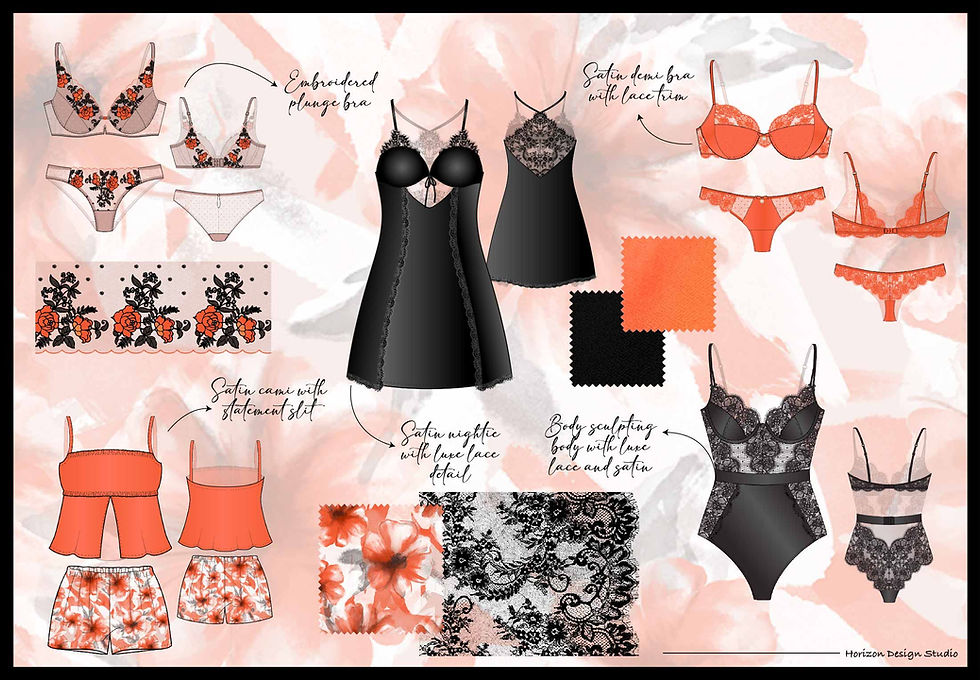The Real Cost of Sampling, Why Your First Sample Will Never Be Your Last
- Ash Rema
- Aug 29
- 4 min read

Launching a lingerie brand is exciting, then the first sample arrives and reality sets in. In lingerie, a perfect first sample is rare. That is not failure, it is the path to a product you can proudly launch.
A real story from my studio
A couple hired me to guide their first bra. The first sample came in. On first look, it was a decent start. Two issues stood out.
• Some instructions from the tech pack were not followed.
• The mill did not have our exact fabric for sampling, we got 25 percent spandex instead of 30 percent, which changed the fit and support.
They went quiet for two days. I reached out, reassured them that two to three rounds are normal, and outlined exactly how we would fix it. Calm, structure, and clear next steps brought the project back on track.
Why first samples miss the mark
Lingerie is a contoured product, small changes create big differences.
• Fabric and foam, stretch percentage, recovery, thickness, liner choice.
• Thread and stitches, SPI, bar tacks, zigzag vs cover, seam placement.
• Elastics and straps, modulus and tension settings.
• Trims and hardware, rings and sliders, hooks and eyes, padding.
• Factory interpretation, when tech packs are not followed line by line.
Your first sample is a diagnosis tool. It tells you what to adjust so the second and third samples get you to approval.
The realistic timeline
Plan for two to three rounds of sampling.
• Each round typically takes three to four weeks.
• Complex styles or material constraints can add time.• Build a calendar that includes lab dips, strike offs, trim approvals, and fit testing.
The sampling playbook I use with startups
1) Before your first sample
Lock the foundation
• Finalise tech packs with construction notes, measurements, and BOM.
• Confirm material specs, target stretch, foam thickness, elastic modulus.
• Share reference photos for stitch types and edge finishes.
Set expectations with the factory
• Confirm they have access to required materials, if not, agree on closest alternatives and document differences.
• Confirm sampling timeline and who signs off each step.
2) When the first sample arrives
Do a calm review first
• Compare to tech pack line by line, mark what was not followed.
• Note fabric differences that could explain fit.
Run a simple try on test
• Test on a fit model within your size range, note comfort, support, gaping, digging, strap behaviour, wing tension, band ride up.
• Photograph front, side, back, natural posture, arms up.
Create your change log
Use a table with columns:- Issue, Evidence, Root cause, Action, Owner, Due date.
Example:-
Issue, band rides up at back
Evidence, photo with posture notes
Root cause, lower modulus elastic and 25 percent spandex
Action, switch to specified elastic, use 30 percent spandex fabric
Owner, factory
Due date, next sample date
3) How to talk to the factory
Stay factual, keep a friendly tone, attach the change log.
Script you can copy
Subject, Sample 01 review and change log
Thank you for Sample 01. Please find attached the change log. Items 1 to 4 are corrections where the tech pack was not followed, please update these as requested. Items 5 to 7 are fit related and likely due to the 25 percent spandex fabric used in sampling, please confirm access to 30 percent spandex for Sample 02.
Kindly share an updated timeline for Sample 02 and confirm material substitutions, many thanks.
4) Approvals that should run in parallel
• Lab dips and strike offs, approve colour and print execution early.
• Trim approvals, elastics, rings, sliders, hooks and eyes.
• Branding trims and labels, avoid last minute surprises.
5) When to move forward
You are ready for a pre production sample when,
• All corrections from tech pack deviations are fixed.
• Fit is consistent on the target size and adjacent sizes.
• Materials match the agreed specification.
• Construction is repeatable and documented.
Common mistakes and how to avoid them
Rushing the process
Two months is not realistic. Plan at least six months.
Skipping tech pack detail
Factories guess when instructions are vague, which costs you time later.
Letting the factory choose materials without oversight
It saves time, but reduces control. If they must choose, approve exact specs.
Confusing seamless with zero seams
Seamless refers to knitting and finish, there are still construction joins.
Dropping brand identity
Even in sampling, colours, trims, and mood should connect back to your brand story.
Brand identity guardrails during sampling
Keep a one page brand lens at hand,
• Colour story and neutrals.
• Fabric personality, airy, sculpting, silky, matte.
• Signature trims, strap width, hardware finish.
• Fit promise, comfort, lift, minimising, romantic support.Use this to make small decisions quickly without losing cohesion.
Your next steps, a simple plan
Schedule your Sample 01 review, mark tech pack deviations, list fit issues.
Send the change log with a friendly, clear email.
Approve trims and colour in parallel.
Plan Sample 02 for three to four weeks later, confirm materials.
Repeat with focus, do not add new wishes mid round unless essential.
Download, Sampling Success Checklist
Keep this beside you during every review.
If this process feels heavy, I can support you through concept, design, sourcing guidance, and sampling. The goal is a product you are proud to launch.
👉 Book a free discovery call to get started.
—————————————————————
I am Ash, founder of Horizon Design Studio, and I specialise in creating bespoke lingerie, swimwear and loungewear designs that reflect today’s market values.





Comments